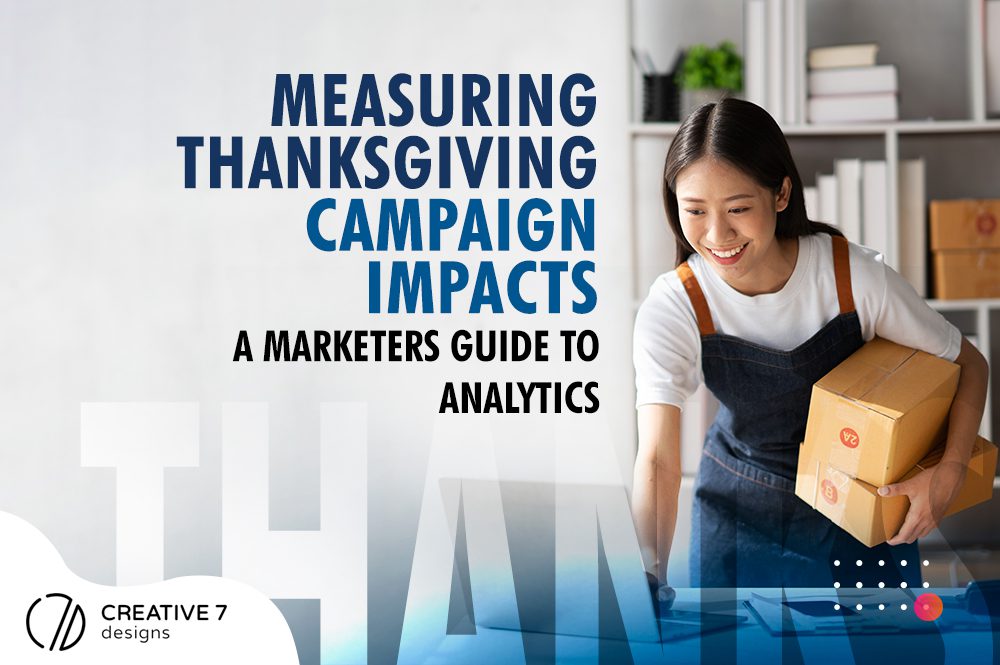Overview: How much is your marketing campaign paying you back? There’s more than just guesswork involved – discover data-driven insights and ROI strategies in our comprehensive guide. Read on to learn how to maximize your marketing dollars and drive success today!
As Thanksgiving approaches, marketers are gearing up for one of the busiest and most competitive times of the year. Thanksgiving is not just a time for turkey and stuffing; it’s also a prime opportunity for marketers to create impactful campaigns that resonate with their target audience. However, as any seasoned marketer knows, the true success of a campaign lies in the data.
So whether you’re running a promotion, a social media campaign, or a special event, the success of your Thanksgiving marketing efforts hinges on your ability to measure their impact accurately and make changes in your strategies accordingly.
Let’s learn some ways to measure your Thanksgiving campaign impacts together!
The Importance of Measuring Campaign Impact
In today’s data-driven marketing landscape, it’s crucial to measure the impact of your campaigns. Thanksgiving is no exception. Understanding the performance of your Thanksgiving campaigns not only allows you to evaluate their effectiveness but also provides valuable insights for future marketing endeavors.
Here are a few reasons why measuring impact is so important:
Optimizing Campaigns: By analyzing the data, you can identify what worked and what didn’t in your Thanksgiving campaign. This information is invaluable for optimizing your future strategies.
Maximizing ROI: Knowing the impact of your campaign helps you allocate your resources more efficiently. You can focus on the channels and strategies that yield the best results.
Customer Insights: Analytics can provide you with valuable insights into your target audience’s preferences, behaviors, and demographics. This knowledge can guide your future marketing efforts.
Competitive Advantage: In a crowded marketplace, staying ahead of the competition requires constant improvement. Measuring campaign impact is a way to do just that.
>> Related Reading: 5 Tips for a Successful Seasonal Marketing Campaign
Setting Goals and KPIs (Key Performance Indicators)
Increase Brand Awareness: If your primary goal is to boost brand visibility during Thanksgiving, your KPIs might include the number of impressions, reach, and share of voice in your industry or niche. You can use tools like Google Alerts or brand monitoring platforms to track mentions and conversations about your brand.
Enhance Customer Engagement: To foster meaningful interactions with your audience, you can set goals to increase likes, shares, comments, and overall engagement on social media platforms. Monitor user-generated content and track engagement metrics using social media analytics tools.
Drive Website Traffic: If your campaign aims to drive more visitors to your website, your KPIs might include metrics such as the number of unique visitors, page views, and the average time spent on your site. You can also monitor the click-through rate (CTR) from your Thanksgiving email marketing campaigns.
Generate Leads: For lead generation campaigns, set objectives related to the number of leads captured. Monitor lead quality by assessing the conversion rate from lead to customer. Track leads throughout their journey, from initial capture to nurturing and conversion.
Increase Sales: If sales are your ultimate goal, measure the campaign’s impact by tracking metrics like revenue, conversion rate, and average order value. To get a more comprehensive view, you can break down sales data byproduct, category, or customer segment.
Boost Customer Loyalty: Thanksgiving is an excellent opportunity to enhance customer loyalty. Track customer retention rates, repeat purchase rates, and Net Promoter Score (NPS) to evaluate the impact of your campaign on customer satisfaction and loyalty.
Remember, your choice of goals and KPIs should align with your overall marketing strategy and the unique objectives of your Thanksgiving campaign. By setting clear and specific KPIs, you can effectively measure the impact of your marketing efforts and make data-informed decisions for future campaigns.
Tools and Data Sources
To measure the impact of your Thanksgiving campaign, you’ll need the right tools and data sources. Here are some essential resources:
Web Analytics: Platforms like Google Analytics can provide detailed insights into website traffic, user behavior, and conversions.
Social Media Analytics: Each social platform (e.g., Facebook, Twitter, Instagram) has its own analytics tools to monitor the performance of your campaigns.
Email Marketing Software: If you’re running email campaigns, tools like MailChimp or HubSpot can provide metrics on email opens, click-through rates, and more.
Sales Data: Your point-of-sale system or e-commerce platform will offer data on sales, revenue, and customer behavior.
Customer Surveys: Collecting feedback from customers through surveys can provide qualitative insights to complement quantitative data.
Competitive Analysis: Keep an eye on your competitors’ strategies and performance to benchmark your own campaign.
>> Related Reading: Top 10 Data Analytics Tools You Need to Know in 2023
How to Analyze Your Thanksgiving Campaign
With your data sources in place, it’s time to start analyzing your Thanksgiving campaign’s impact. Here’s a step-by-step guide:
Data Collection: Gather data from all relevant sources. Ensure data accuracy and consistency.
Data Visualization: Use graphs, charts, and dashboards to visualize your data. Tools like Tableau, Power BI, or Google Data Studio can help.
Performance Metrics: Calculate the KPIs you established earlier and track their performance over time.
Segmentation: Break down the data into segments, such as demographics, geography, or referral sources, to gain insights into which segments perform best.
A/B Testing: If applicable, compare different elements of your campaign to see what resonates most with your audience.
Customer Journey Mapping: Understand how customers interact with your campaign and identify areas for improvement.
ROI Calculation: Determine the Return on Investment by comparing the costs of the campaign to the revenue generated.
Competitive Analysis: Benchmark your campaign’s performance against your competitors to identify strengths and weaknesses.
Making Informed Decisions
Once you’ve analyzed your Thanksgiving campaign’s impact, it’s time to make informed decisions based on your findings.
Here are some actions you can take:
Adjust Campaign Strategy: Use your insights to refine your marketing strategy for the next Thanksgiving campaign or any other upcoming events.
Invest in High-Performing Channels: Allocate more resources to channels and tactics that yielded the best results.
Personalize Campaigns: Tailor your messaging and offers to different customer segments based on the data you’ve collected.
Optimize Conversions: Identify points in the customer journey where you’re losing potential customers and make improvements.
Enhance Customer Experience: Use feedback and data to enhance the overall customer experience, increasing customer satisfaction and loyalty.
Budget Allocation: Allocate your marketing budget more effectively by prioritizing initiatives that have a proven track record.
In Summary
Measuring the impact of your Thanksgiving campaign is not just a post-mortem exercise but a critical part of your marketing strategy. By setting clear goals, using the right tools, and analyzing the data effectively, you can gain valuable insights and continually improve your marketing efforts.
This Thanksgiving, take your marketing campaigns to the next level by harnessing the power of analytics. Your success in the holiday season and beyond depends on it. Or reach out to a marketing agency like Creative 7 Designs to do the job for you while you focus on seizing opportunities!


